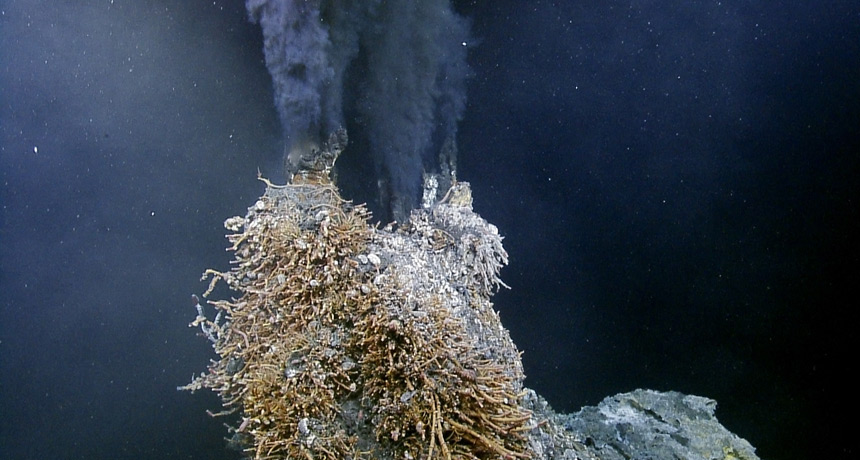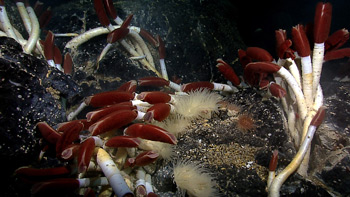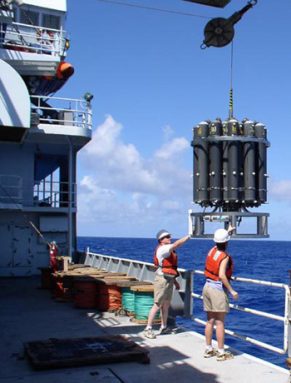Seafloor hosts surprising number of deep-sea vents
New tool found them by sensing changes to seawater from vented chemicals

Hydrothermal vents in the deep ocean are much more common than scientists had thought, new research shows.
OCEAN NETWORKS CANADA/FLICKR (CC BY-NC-SA 2.0)
Share this:
- Share via email (Opens in new window) Email
- Click to share on Facebook (Opens in new window) Facebook
- Click to share on X (Opens in new window) X
- Click to share on Pinterest (Opens in new window) Pinterest
- Click to share on Reddit (Opens in new window) Reddit
- Share to Google Classroom (Opens in new window) Google Classroom
- Click to print (Opens in new window) Print
The ocean bottom is deep and dark, but far from lifeless. New research shows that it teems with far more oases of life than anyone had imagined.
Earth’s surface rock (and the soil or sand above it) moves slowly atop shifting rocky slabs known as tectonic plates. Deep along the sunless seafloor, some of those tectonic plates pull apart. Near these plate boundaries, seawater seeps down and gets heated by molten rock. Then the hot water erupts back up as an underwater hot spring. This is known as a hydrothermal vent. As the water moves upward it brings with it dissolved minerals, such as iron. Those minerals settle out to form smokestack-like towers. And these can house bizarre ecosystems. Giant tube worms, eyeless shrimps and ghostly white crabs thrive in and around the nutrient-rich hot water.
Regions where tectonic plates are separating are known as spreading ridges. These spreading ridges have at least three to six times as many hydrothermal vents as scientists had expected, a new study reports.
Researchers found these vents spaced along the spreading ridges every 3 to 20 kilometers (1 to 3 miles). Until now, seafloor scientists had thought vents were usually tens if not hundreds of kilometers apart, notes Edward Baker. He is an oceanographer at the University of Washington in Seattle. He is also a coauthor of the new study.

The discovery of so many new vents solves a mystery. No one knew how critters moved between faraway vents, says Cindy van Dover. She’s an oceanographer at Duke University who was not involved in the new work. Van Dover says that these animals aren’t very mobile and their offspring can’t travel very far. But scientists have found genetically related groups living far apart. The new results show that “there are even more stepping stones than we thought,” she says. “This helps us understand the resilience of these communities and how they relocate.”
How they came up with the new estimate
Vent hunters typically search by sight. They look for the smokelike streams of particles that hydrothermal vents tend to belch into the water. Such smoke signals can extend outward for tens of kilometers in any direction. That makes it difficult to tell whether the “smoke” is coming from individual vents or some closely grouped cluster of them. And vents with lower temperatures tend to release few particles. That makes these especially hard to spot.
Baker and his colleagues went looking for vents using a special new sensor. It helped them find vents they otherwise would have missed. The sensor works by scanning for chemicals that all vents expel. These include unoxidized iron and sulfur. When these chemicals mix with seawater, they create slight changes in its electrical properties. The spewed chemicals don’t hang around long once they leave the vent. That means they are only detectable when a vent is nearby.

The sensor also was able to distinguish between vents that are close together. It could identify individual vents that were only a kilometer (0.6 miles) or more apart. How? The chemicals it detects don’t drift as far as particles from the smokelike plumes.
The scientists scoured 1,470 kilometers (913 miles) of seafloor in the eastern Pacific Ocean. They used a ship to tow their new sensor, which hovered a few hundred meters above the spreading ridges. This survey turned up 184 distinct vent sites. That was far more than had been expected, based on previous vent counts. Those earlier studies had missed roughly one in four vents because they had low temperatures and few visible particles.
The new data also may apply to other spreading ridges, such as those in the Atlantic and Indian oceans.
“They’re not all big,” Baker says of the new hydrothermal vents. “They’re not all the iconic black smokers. But they’re places that likely support ecosystems,” he notes. “So there’s way more places on the seafloor where animals can survive.”
Baker’s team reports its findings in the September 1 Earth and Planetary Science Letters.
Hydrothermal vents affect life far beyond the ocean floor, Baker adds. Iron is an important nutrient for lots of marine life. Iron released from the vents can travel thousands of kilometers and is used by ocean life worldwide.







